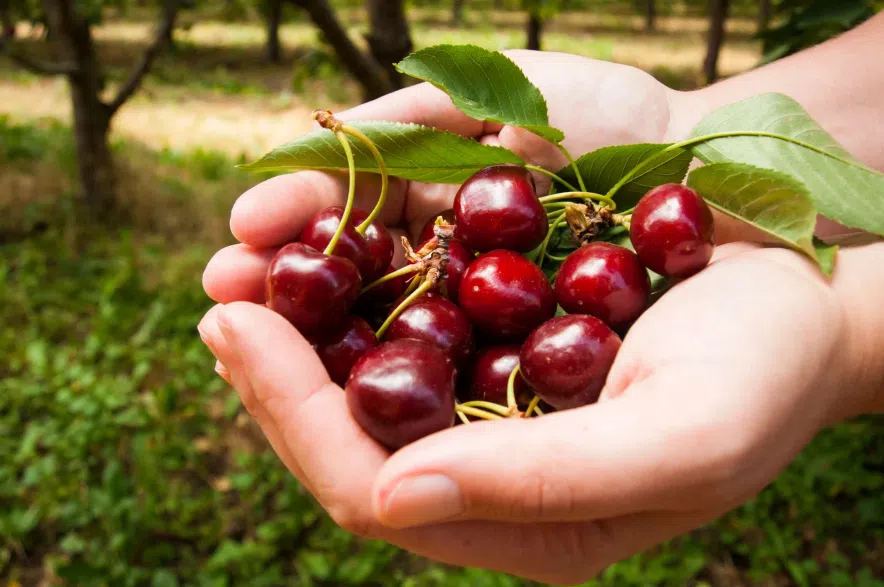Jill and Rick Van Duyvendyk answer all your gardening questions in Garden Talk on 650 CKOM and 980 CJME every Sunday morning at 9 a.m. Here are some questions and answers from the July 6 show:
Read more:
- Garden Talk: Give your summer lawn some love
- Garden Talk: Save money by being water wise in your yard this summer
- Garden Talk: Xeriscaping a water-conscious alternative to having a lawn
These questions and answers have been edited and condensed for clarity.
Q: How can I prevent maggots in my cherries?
A: The best way is pick them and dispose of them. Don’t leave them to sit on the ground or the maggots go down into the ground and become flies again next year. You have to stop that cycle.
There are sprays, but you have to apply them at the right time and every year the flies emerge a different time so it’s really hard to get them. The flies will come up in around the middle of June to the middle of July. Sticky traps can help, too.
Q: How can I tell if my apple tree is alive? It had no leaves or blooms in spring and at the edge of some of the shoots from the bottom is a faint light green colour when chopped off.
A: Check around the trunk of the tree to see if voles, mice or rabbits have chewed the trunk. If there is a cover at the bottom to stop animals chewing it, it needs to be removed in the spring and clear any grass away so it is not right up against the trunk.
If you leave those covers on, the trunk gets too moist. Grass clippings fly into them or bark goes into them and the bark can rot when covered by them so only put them back on in the fall.
One of the biggest killers of trees is also careless use of whipper snippers.
If the shoots are coming from the bottom below the graft then you’re just going to have a wild apple tree but if they are coming from above the graft then that will still be the same apple tree that you had before.
It sounds like the top of the tree is is done but with the roots are alive like if it has suckers coming up it might also be affected by sun scald, an animal or a severe winter.
Q: What would cause an dwarf Alberta white spruce to turn yellow and dry up?
A: Dwarf Alberta white spruce are not all that hardy. What happens in the spring if you don’t wrap them they will turn brown at the top and then they come back.
They put new growth on to come back and some years they come back better than others. They are a gardener’s challenge in Saskatchewan.
You have to put them in a sheltered location which has not too much winter sun and especially put burlap around them. Despite the name, they don’t even survive in Calgary because they get Chinook winds, which wipe them right out.
Fertilize it with 30-10-10 every three weeks until about this time of the year right now,
and then quit, and it will push out lots of new growth.
Before the ground freezes, put stakes around the tree and then burlap. If you want to cover the whole thing over make sure you leave it about at least six inches off the ground so the snow can go in around the roots.
A better choice to grow here would be Ohlendorf spruce. It looks very similar, but it’s way tougher. Another one is Green Penguin Scots pine. It grows a little bit slower.
Q: What’s a good drought tolerant, low maintenance alternative to growing grass on an acreage?
A: There are lots of drought-tolerant grass seeds. Early’s Farm and Garden Centre in Saskatoon supplies seed to the Ministry of Highways, sports fields and golf courses, and they make their own blends.
Most of my acreages have a blend called Western parks and there’s also a sports field mix that are both drought tolerant. They don’t grow much and get a little bit clumpy at times, but they’re not bad. Western parks does turn brown in a drought but the next time it rains it greens right back up again. It doesn’t die.
Clover needs to get established first because the roots go down to where the water is. If you use a clover mix you will need fill in all the spots until the clover gets older. It is drought tolerant once established, because the roots go down deep to the subsoil moisture. You might get some winter kill on it and need to reseed every once in a while.
You could try a dry land mix and clover. Remember you’re not going for the perfectly manicured lawn look when you’re using these mixes.
Q: Can I add alsike clover or red creeping thyme to my back lawn?
A: One thing that you’re going to find if you do is you’re not going to have a uniform lawn look, it is going to look like a meadow lawn.
Some places are gonna grow faster than others thyme is going yo grow a little bit more moundy and look good in the first part of the summer but not as good in the second part of the season.
It will look a little bit patchy and you’re gonna have to get into a routine of cutting it and being okay with it being different heights. One thing you’re gonna have to watch is where you set your lawnmower when you cut it. Some of these plants that that grow a little bit more moundy, you will cut the the foliage off if it is too low and they won’t survive. Set it at three inches or even more.
If you’re unsure if you’re going to like the result, try it in an eight by four section of your yard and see. Remember it’s going to take multiple years to thicken up, too.
When planting a meadow lawn you still have to go through it and take out bigger weeds or else you’ll have a messy look. A lot of them will be annual weeds but there’ll also be some perennials in there.
Q: What can we do about mole hills on our acreage?
A: For moles you need a black hole trap.
Q: How do I care for a phalaenopsis orchid?
A: It needs sunlight and once every few weeks put it in a sink of water with some orchid food and just let it soak there for about 10 minutes, drain it and then put it back into the sun.
After it’s finished blooming, you can let the stalk die back a little bit and then cut it down to the base after a couple weeks. Keep it in a sunny area and usually you’ll see it bloom about once or twice a year. It’s a beautiful flowering plant for your house.
Q: When can I cut back iris plants?
A: Don’t cut them back until the leaves are turning yellow because if they are green then the plant is still actively growing. You want the rhizomes in soil just to build up energy. You can cut the flower stem down, but don’t cut the leaves until they turn.
Q: When should I band and unband elm trees for cankerworms?
A: Put the bands on around the September long weekend, and you can leave it up until around June 1. If you leave the bands on you will get mould underneath your plastic that will rot the bark away.
Q: How can I prevent bugs at the blossom stage of plums which stop fruit forming?
A: Spray before and after the blossom stage, but not during it. Use Bug-X Out. Spraying during flowering will mean the blooms don’t get pollinated properly and you will hurt the bees.
Q: What’s the best fertilizer for a juniper Blue Arrow?
A: Blue Arrow is an upright juniper and you want to fertilize it every three weeks with a 30-10 -10 mix from around Mother’s Day until about July 15. The 30-10-10 has an acid base and junipers like acidic soil. If you want them to be more blue you can add a little bit of aluminum sulfate at the same time.
Q: Can I apply 13-33-0-15 fertilizer to my corn with a lawn fertilizer spreader?
A: It’s pretty high in phosphorus, but corn needs lots of nutrients. Rather than putting in a spreader carefully band it down each side of the corn rows. Lay it by hand, but don’t dump it because that’ll burn the plants.
Corn doesn’t like like too much nitrogen when the crop is maturing, and you don’t want to use a fertlilizer high in phosphorus regularly through the season. You want a well balanced one. When it’s maturing, make sure that you’re not using like a 30-10-10 or something like that with high nitrogen.
Corn loves magnesium, boron, and calcium. Humic substances are great because they help the soil release a lot of the nutrients for the plant as well.
Q: Is it too late in the season to start a raspberry patch?
A: No. If you’re moving a raspberry patch, it’s probably too late but if you’re wanting just to start one, you can definitely put some canes in the ground as long as you’re not going to take off on holiday for two weeks after you plant them. They need water to get them established.
Q: Why are the leaves of my hydrangeas curling up?
A: It could be aphids. They’ll be on the bottom side of leaves so take a look. Also watch your watering. Sometimes too much or not enough watering can cause that.
Q: Can orange Asiatic lilies be divided?
A: Yes. They are a bulb, so the best time to divide them is the early spring. Mark where each one is with a small flag that you stick in the ground. You can dig them up in the fall and replant in spring.
Q: I have lots of cherry tomatoes but no new flowers on my plant. Is it finished for the season?
A: You could get it to bloom again but it depends on how early it was started. If it was started back in February in a greenhouse it might just be towards the end of its season. They do have an end life eventually. Give it some fertilizer and see.
Q: How can I tell if a maple tree planted in clay has root rot?
A: Use a piece of rebar and poke it down to the bottom of the planting hole. It has ribs on it and when you bring it up, it also brings a soil sample. If you find it is sopping wet down there, just poke a bunch more holes to aerate it.
If it’s planted in a low spot, build pitchers mounds about three inches taller than that area and then plant your tree with the top of the root ball to the top of the pitcher’s mound and make a little moat on the top to hold water. The mound has to be wider than your planting hole but not wider than the root ball.
Q: Is there a non-suckering white lilac I can plant?
A: No, they white ones are all suckering varieties. There are light pink ones like Villous that don’t sucker.
Q: What can I plant that has white fragrant flowers and doesn’t sucker?
A: Mock orange is a beautiful plant which has lots of flowers and doesn’t sucker. A viburnum Snowball as well, but it will grow nine to 10 feet.
Read more:











